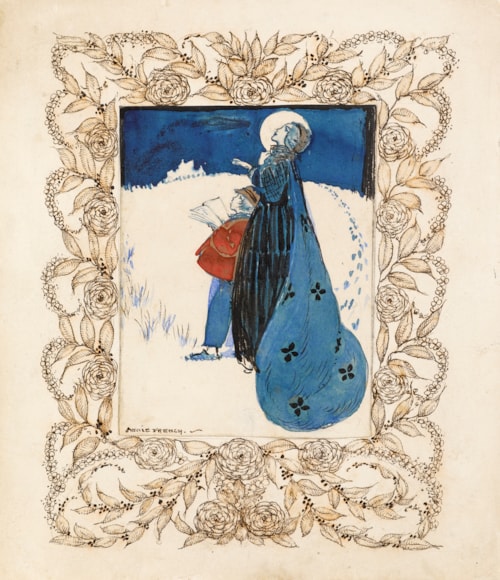
Annie FRENCH
Glasgow 1872 - Jersey 1965
Biography
Encouraged in her artistic ambitions by her parents, Annie French was trained at the Glasgow School of Art and was active as an illustrator in the first quarter of the 20th Century. She produced children’s book illustrations, designs for greeting cards - for which she was perhaps best known in her lifetime - and independent compositions in watercolour on vellum. Her work was often on a small scale and was drawn in an elaborate Art Nouveau style that displays the particular influence of the work of Aubrey Beardsley. As was already noted of French’s draughtsmanship in an early appraisal of her work, published in The Studio magazine in 1905, ‘It will be noticed in these drawings that, in place of the strength and the variety of the Beardsley line, in exchange for the expressiveness with which genius informed it, we have an exquisite pattern woven from a fanciful usage of the dots and lines his method suggested. The drawings are much more to Miss French’s credit than any imitation of the qualities of the Beardsley line; as it is, they are not an imitation, but a device, charming, original, and dainty. One motif from Beardsley’s work has been retained, rearranged, and used for the sake of itself, combined with many qualities that entirely are Miss French’s own.’
French’s work was first exhibited in 1903, while she was still a student, at the Salon in Brussels, and in later years she exhibited at the Royal Scottish Academy and the Royal Glasgow Institute of Fine Arts, where she showed until 1924. In 1909 French succeeded Jessie M. King in the Department of Design at the Glasgow School of Art, teaching ceramic decoration. In 1914 French married the printmaker George Wooliscroft Rhead and settled in London, although he died a few years later. She eventually retired to Jersey where, suffering from failing eyesight, she died in 1965.
The drawings of Annie French are usually quite small in scale, and are characterized by both an intricacy of composition and a delicacy of handling. As one modern scholar has noted, ‘Her backgrounds are extremely detailed, full of flowers, green swards, plants, trees. Mechanisms and industry do not appear. There is considerable variation in tone, which is achieved by fine and finer pen lines, dots and dotted lines, hatching. The darkest patches are usually complex hatching, not plain solid black. It is a style requiring time, patience, and considerable invention. Where colour is used it is generally applied decoratively, with an eye to pattern. The work is a line drawing with colour, not a watercolour with lines, although sometimes lines are used over the colour again. Very often the base of the work is a brown paper.’
Drawings by Annie French are today in the collections of the Scottish National Gallery of Modern Art in Edinburgh, the Victoria and Albert Museum in London, the Laing Art Gallery in Newcastle and the Glasgow Museums and Art Galleries at Kelvingrove, which houses a small album of her drawings.




